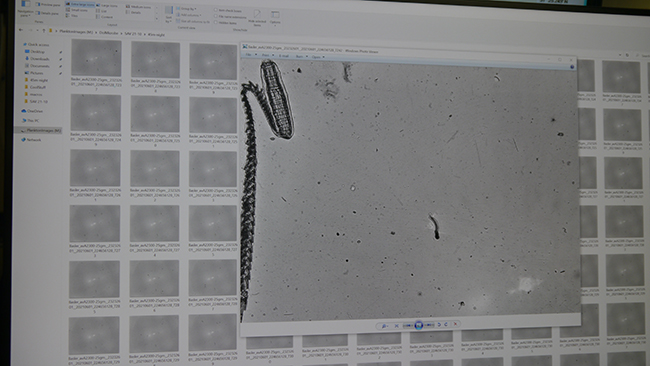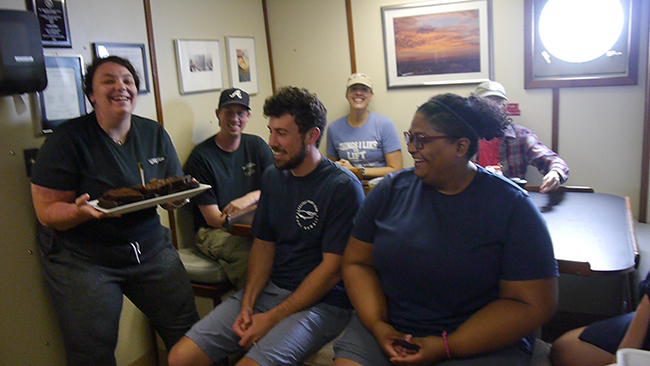by Anita Minniefield
Research Professional
This cruise got off to a rocky start with higher than anticipated waves, sending the science crew (me) into the throws of sickness. Even though this was my fourth cruise, it was my first time getting sea sick on the R/V Savannah. I spent a lot of time on the deck, staring into the ocean and contemplating my life choices- mostly the choice of not taking sea sickness medication the night before the cruise.
Even with the rough conditions, we still pushed forward with the mission of collecting data and trying to find doliolids. When people ask me what we do on these cruises, I always respond with something along the lines of, “collecting doliolids”, which is usually followed up by a conversation about what doliolids are, a type of pelagic filter feeding tunicate.

Doliolid gegenbauri nurse imaged in situ with the mini Deep Plankton Imager (mDPI) during the DolMICROBE_08 cruise
If you are interested in learning more about doliolids, check out our project web page where we have lots of interesting information available https://www.skio.uga.edu/dol-microbe/
While trying to collect doliolids is a major part of the cruises, we also aggregate a lot of other data to compare conditions for when doliolids are and are not present.
There are over ten methods we use to collect different types of data, and the two that I operated for this cruise were the FIRe (Fluorescence Induction and Relaxation) fluorometer and the RNA stations.
![]()
Me (top) filtering water to collect bacterial messenger RNA (mRNA) and (bottom) measuring photosynthetic activity using the FIRe fluorometer.
The FIRe fluorometer measures variable fluorescence in photosynthetic organisms. After collecting water from the surface and at depth, the samples are dark adapted for 15-20 minutes. Once dark adapted, the sample is placed into the FIRe, where it excited by a LED light and the relative photosynthetic activity is measured. Since the samples tend to have very low levels of photosynthetic activity, we are measuring at the lower limit of the FIRe’s sensitivity but the machine is going to be upgraded, which will expand the range of the FIRe and yield more accurate results.
The RNA station is a rig Dr. Frischer constructed to rapidly vacuum filter water through 0.22 micron filters. When doing this, we need to work as quickly as possible because RNA is very fragile and degrades quickly. In my experience, RNA does not do well at room temperature and needs to be kept as cold as possible. After filtering, we take further action to preserve the RNA by filling the filter with RNA stabilization solution and then putting the samples in liquid nitrogen until we can store them at -80°C in the lab. The RNA from the filters will later be extracted and analyzed for transcriptomics to see what genes are present and being expressed in different conditions.
We also have our fun on these cruises when we have time. During our safety briefing, given by ship crew member Joe Bartman, graduate student Abby McCormick demonstrated how to put on the immersion suit. The immersion suit is designed to keep you floating and warm in the water in case of an emergency that required us to abandon the ship.
Graduate student Abby McCormick demonstrating the use of an immersion suit during the safety briefing at the start of the cruise.
Finally, as much as I tried to keep it a secret, it was discovered by the crew that it was my birthday! Our lovely chef Ben Leland was able to whip up some delicious brownies for me last minute and the science crew celebrated my birthday together.

Celebrating my birthday during the cruise. Surprise!


